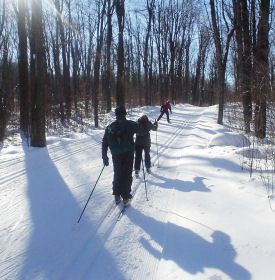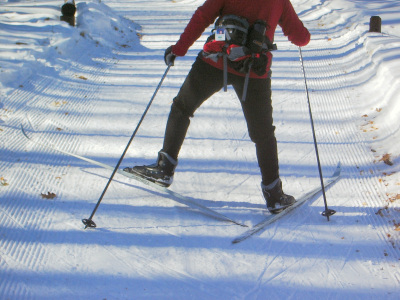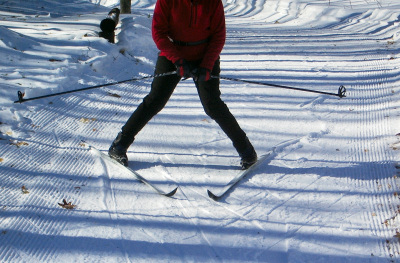There are two basic types of cross-country skiing. One is classic-skiing, and the other skate-skiing.
Needless to say, skate-skiing resembles skating. Although it is faster than classic-skiing, it requires more physical effort, greater know-how, specialized skate skis, and is generally dependent on the availability of wider trails that are well groomed.
 The couple are classic cross-country skiing on groomed tracks in the Gatineau Park. The person in front
The couple are classic cross-country skiing on groomed tracks in the Gatineau Park. The person in front
(in the distance) is skate skiing. |
Classic-skiing involves moving the skies parallel to one another. It is easier than skate skiing and require less physical effort, but it is slower. Although many people do their classic-skiing on groomed trails (where two tracks or slots are set in the snow), it is possible to do this type of skiing on semi-groomed trails, or even in the absence of any groomed trails at all.
When you go off the groomed trails, it's called back-country skiing. This type of classic cross-country skiing is obviously more strenuous. People who do a lot of it generally use skis that are specially made for back-country skiing. These are a little wider and more rugged that what is often used for recreational cross-country skiing.
The information on this web page is primarily concerned with classic skiing on groomed trails (which is a good starting point for most people who are new to cross-country skiing).
Where to Start & How Far to Go
If you are cross-country skiing for the first time, you may want to start off on some of the NCC Greenbelt trails, which tend to be flatter and easier than those in the Gatineau Park. Not all Greenbelt trails have freshly groomed tracks, but this is something you should look for because it makes learning all the more easier.
If you do start in Gatineau Park, it may be best to stick with the easier trails that have smaller hills. Although it doesn't lead to a cabin, the trail between P8 and P9 is a good choice for people on their first visit to the park because it isn't too long and doesn't have any really big hills. When choosing a trail in the Gatineau Park, it is a good idea to check the NCC web site to verify the conditions of the trails and see if they were groomed in the last 24 to 48 hours.
Once you have figured out the basics, and if you are in good health and reasonably fit, skiing 10 to 15 kilometres in an afternoon isn't excessive. This makes for an nice outing and puts you within striking distance of many of the more interesting areas in the Gatineau Park.
However, if you are just starting off, and still working on getting yourself in shape for cross-country skiing, you will obviously want to limit yourself to a shorter distance for the first few outings. You'll also discover that cross-country skiing works certain muscles that normally don't get all that much use. In other words, expect to be sore in a few places the day after your first real cross-country ski. Fortunately, both you and your muscles will quickly get used to everything after two or three outings, assuming you are going out at least once a week. So keep at it.
Going Cross-country Skiing for the First Time
You have purchased, borrowed, or rented you cross-country skis, you have applied the right wax, you are properly dressed, you're at the trail. Now what? Well, it's really quite simple. Put on your skis, pick up the poles, get on the track, and go.
You'll naturally end up using a technique some people call the "shuffle". It involves nothing more than sliding one ski ahead of the other, and repeating the entire process over and over again. Without even thinking about it, you'll be pushing off with a kick stride, moving forward with a glide stride, and vice-versa. At the same time, you'll intuitively use your poles for balance and to help push yourself forward with every stride. It's very easy to do, and you will get in the swing of things after five or ten minutes. What's more, you'll fit in with the many skiers (perhaps the majority) who show up at popular trails on sunny weekend afternoons and use nothing more complicated than this shuffle technique.
When you get comfortable on your skis, you should try to gradually improve your performance. Work on maximizing your forward gliding motion. Concentrate on transferring a bit more of your weight onto the ski that is sliding forward. At the same time, try leaning forward a bit and while keeping a slight bend in your knees. Once you get use to doing this, put a little more energy into kick-off stride and use you poles a little more aggressively. You'll also improve your technique by planting your poles relatively close to the side of the skies in the area next to your toes.
If all this sounds a little complicated, don't worry. The shuffle stride is more than adequate to get you started, and many recreational skiers never move beyond this technique. Nevertheless, you should set your sights on trying to improve your performance once you feel ready.
Going up Hills (the herringbone technique)
When going skiing in Gatineau Park or on trails that are less than flat, you will have to know how to go up hills.
The standard shuffle technique will get you up mild slopes, but as things get steeper, you notice some slippage when the kick stride starts to lose traction. To a certain extent, you can counter this slippage by
 the herringbone technique - note how the inside edge of the ski is angled down.
the herringbone technique - note how the inside edge of the ski is angled down. | pushing down with all your weight on the ski that you are kicking off with. This flattens out the camber of the ski (the slight upward arch in ski's the shape), and brings the grip wax or moulded pattern in the kick zone into maximum contact with the snow.
Once a hill gets too steep, you will have to use the herringbone technique. You do this by pointing the tips of you skis outwards and walking up the hill (see the photo). The trick to successfully using this technique is to make sure the inside edge of the ski is angled down. This allows the edge to dig into the snow giving the necessary traction to walk up the hill. Don't forget to simultaneously use your poles to help push you up the slopes and hills.
It's called the herringbone technique because it leaves a herringbone pattern in the snow. You will probably find it awkward the first time you use it, but you'll get used to it after a while. It can be tiring when using this technique to climb a succession of relatively steep hills. You can give yourself some encouragement under these circumstances by thinking of the free ride you'll get coming down the hills on your way back.
Going down Hills (the snowplow technique)
What goes up must come down. Once you used the herringbone technique for climbing, you'll have to know how to descend a hill.
Going down a long gentle slope is fun and easy. Keep skis in the tracks and enjoy the ride. But coming down a relatively narrow trail on a steep hill can be scary and dangerous.
 the snowplow technique - note how the inside edge of the ski is angled down.
the snowplow technique - note how the inside edge of the ski is angled down. | Under these conditions, it is important to use the snowplow technique to reduce your speed. You do this by keeping the tips of the skis pointed inwards (see the photo). Again, the trick to successfully using this technique is to keep the inside edges of the skis angled downwards. This allows the edge to dig into the snow and maximize your breaking power.
As a beginner, you should start applying the snowplow technique at the very top of a hill before you have had a chance to pick up too much speed. If you do find yourself going down too fast, your only option may be to sit down. This may not be most elegant technique for slowing down, but it's effective. If you do decide to take off your skis and walk down a steep hill, stay well off to the side of the trail to avoid doing any damage to the groomed areas.
A few points about Skiing in Gatineau Park
When you stop for a rest or to talk with friends, please get off the track. Remember that on shared trails, the centre portion is used by skate-skiers, so it is best to go to the side of the trail.
The people who groom the trails in the Gatineau Park do not set tracks (slots set in the snow) on the portion of trails going down the steeper hills. This means that if you are starting to head down a slope, and see the groomed tracks disappear, it's a sure sign that you should start snow plowing to avoid going too fast. Also remember that the tracks can become very slick and fast under certain temperature conditions, or after a day of heavy use. When this happens, you may want to begin snow plowing well before the tracks disappear.
Most skiers only have limited control or limited options when coming down a fast steep hill. It is therefore important for people to yield to skiers coming down a hill.
Skiing in the Gatineau Park sometimes means you'll be out for half day. If you aren't in the habit of doing so, you may want to bring a small packsack or waist pack with some drinking water, snacks to replenish your energy, any extra clothing that might be needed, a map of the park, and various kick (grip) waxes. It's usually a good idea to bring the recommended wax as well as waxes suitable for the neighbouring temperature zones.
Cross-Country Ski Technique & Lessons
It should be obvious that the information provided here represents the minimum needed to get started in classic cross-country skiing. If you get in a bit practice and build up your stamina, you'll soon be doing as well as many, if not the majority, of the recreational skiers
who head out on weekend afternoons.
However, after a while, you'll notice that there are skiers who seem to go a little faster, and a little further, with every stride. These are the skiers who have developed a good cross-country technique. The added performance that comes with good technique can make a big difference when covering longer distances. You will be able improve your technique with practice, by watching others, and maybe by doing a some reading. In fact, when good skiers passes you on the trail, try to keep up with them for a while. Study how they kick off their strides, how they use their poles,
and how they transfer their weight onto the ski that is gliding forward. Try to mimic their actions as a means of improving your technique. You may also want to check out a free e-book about cross-country skiing techniques produced by XCZONE.TV (a locally based organizations).
Whatever the case, one of the best ways to improve your performance is to take cross-country ski lessons. Various cross-country ski clubs and the City of Ottawa offer courses. Moreover, there is a good number of qualified cross-country ski instructors who are able to provide private or semi private lessons. Although not absolutely a necessity, you may want to look for instructors who are certified with CANSI (Canadian Association of Nordic Ski Instructors). People at many of the better cross-country ski stores should be able to you put in touch with various instructors, and the XC-Ottawa web site also has useful information about taking lessons or courses.
© Michael McGoldrick, 2006.
|

